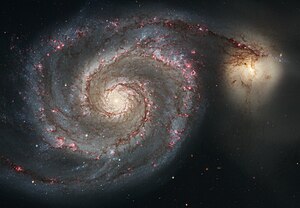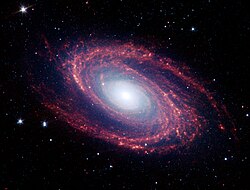Spiral arm

As spiral galaxies are spiral arm of galaxies called. They are composed of gas and bright stars and separated from one another by less bright, only apparently empty spaces. Galaxies with this structure are therefore also called spiral galaxies .
Astronomical meaning
The spiral arms are areas of star formation, which continues to this day, and were first observed visually at the beginning of the 19th century and first photographed around 1880. In the Andromeda nebula M 31 (see picture), Edwin Hubble was able to resolve the outermost regions into single stars in the 1920s and thereby prove that the spiral galaxies are not, as initially assumed, gas or dust nebulae , but huge star systems. The existence of spiral arms in the Milky Way was first demonstrated in 1951 by a team led by William Morgan .
The spiral arms arise from the interaction of gravitation and star formation and therefore contain large amounts of gas . The gaseous hydrogen has been detected by its 21 cm radio emission ( HI line ) since around 1950 and allows the structure of our Milky Way to be explored behind the center of the Milky Way, which is hidden in the optical range of the spectrum by large dark clouds .
Emergence

Even if a spiral galaxy looks like it only exists within its spiral arms, the areas between the spiral arms are not empty, but simply less bright . There are also a relatively large number of stars here.
Which processes are responsible for the development of the spiral structure has not yet been clearly clarified. However, it is clear that the stars belonging to the spiral arms do not form a rigid structure that rotates in formation around the respective galaxy center. If this were the case, the arm structure of a spiral galaxy would wrap itself up within a relatively short time due to the different orbital speeds and become unrecognizable. So a galaxy does not rotate rigidly like a wheel; rather , the individual stars run out of and into the spiral arms during their orbit around the center.
An explanation is provided by the thesis that the spiral arms are visible expressions of standing density waves (like sound waves in air) that circulate in the galactic disk. This density wave theory was first proposed by Chia-Chiao Lin and Frank Shu in the 1960s. The spiral arms are zones of increased matter density and star formation, which move through the disk at a different speed than the individual stars. During their lifetime, stars move away from their birthplaces and spread across the disk. Particularly massive and luminous stars, however, due to their shorter lifespan, do not move that far away from their areas of origin, which is why they then emerge as bright spiral arms. Therefore, the stellar objects located there mainly include stars of the spectral classes O and B, supergiants and Cepheids , all younger than 100 million years. However, they represent only a small percentage of the stars in a spiral galaxy. Most of the mass of such a star system consists of old, low-mass stars that can move far away from the spiral arms in the course of their long life.
The density waves are created by the interplay of all star orbits , because the stars do not move around a fixed center (a black hole in the center of the galaxy) like the planets in the solar system , because the total mass of the galaxy is not concentrated enough for this. Therefore, a star does not return to its starting point after one orbit around the center of the galaxy, so the orbits are not ellipses , but have the shape of rosettes . Density waves are created when many stars move at the same speed. Thus, in a barred spiral galaxy all tracks equally aligned against each other, however, moved in a pure spiral galaxy even up to today. The orbits are synchronized by means of gravitational feedback .
The formation of spiral arms can be modeled using computer simulations that also take interstellar gas into account. It shows that these are by no means static, but arise and disappear. After that, every galaxy goes through a cyclical transformation from the bar to the pure spiral shape and back with a period of approx. 10 billion years. Furthermore, the spiral arms disrupt the trajectories of the stars, which leads to the so-called Lindblad resonances .

